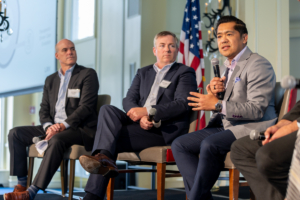Each year, the LRVHealth Annual Meeting brings together our full network of strategic limited partners, portfolio company CEOs, and executive advisors for a day of meaningful dialogue and connection — and 2025 was our largest and most memorable gathering yet.
Held in Boston, this year’s meeting marked LRVHealth’s 25th anniversary and came at a time of profound uncertainty across the healthcare landscape. Throughout the day, we explored how long-standing pressures, now intensified by today’s political, economic, and regulatory climate, are creating the conditions for structural change in our healthcare system with far-reaching consequences and opportunities.
Against that backdrop, we explored four market shifts that we believe will shape healthcare over the next decade: Targeted Value Alignment; The New Healthcare Productivity Frontier; A Distributed and Personalized Care Ecosystem; and A Therapeutic-Driven Care Evolution. We were grateful to hear perspectives from across our network on these shifts and the opportunities for innovation and investment they present.
We’ve gathered some of the key takeaways from this year’s Annual Meeting.

From VBC Everywhere to Targeted Value Alignment: Lessons Learned and the Next Iteration of “Value-Based Care”
What has the industry learned from our value-based care journey to date, and where do we go from here? In this panel, leaders from across healthcare came together to reflect on past efforts, examine what’s working and what’s not, and share ideas for a more targeted approach to value alignment and cost containment. Moderated by Ellen Herlacher, Partner at LRVHealth, the panel featured Bennett Graham, President, Main Street Health; Sylvia Hastanan, Founder & CEO, Greater Good Health; Tony Keck, EVP for System Innovation and Chief Population Health Officer, Ballad Health; and Ali Khan, MD, Chief Medical Officer, Medicare, Aetna (a CVS Health Company).
Key takeaways from the panel:
- The early innings of value-based care have shown promise. We’ve seen a basic validation of the VBC principle: that populations in value-based contracts have better outcomes and lower costs.
- However, much more needs to be done to address current and future pressures on the healthcare system. The cost structure of care delivery must come down, points of friction and misalignment between healthcare constituents must be ironed out, and contracting must more accurately incent and capture value creation.
- Innovations in AI and automation have the potential to lower the cost structure of care delivery by more precisely assigning therapies and clinical resources based on acuity.
- There are many provider re-orchestration and administrative levers to pull that are less tech-intensive, yet still fairly innovative. Among those are business models and attribution frameworks that transition healthcare systems and specialists off of pure fee-for-service into more value-oriented modes of care. In addition to those, there are alternative forms of staffing and “extender” models that help expand access to care in rural and underserved communities.

Right Site, Right Time, Right Care: Moving from a Monolithic to a Distributed and Personalized Care Ecosystem
Delivering on the promise of value means rethinking where, how, and when care is delivered. In this panel, health system executives discussed how their organizations are navigating site-of-care shifts and reimagining care delivery to better meet patients where they are. Moderated by Keith Figlioli, Managing Partner at LRVHealth, the panel included insights from Jonathan Gleason, MD, EVP, Chief Clinical Officer, Prisma Health; Jesse Longoria, SVP and Chief Strategy & Growth Officer, OhioHealth; Joel L. Vengco, SVP, Information Technology Services, and Chief Information and Digital Officer, Hartford HealthCare; and Laura Wilt, SVP and Chief Digital Officer, Sutter Health.
Highlights from the panel:
- Providers have traditionally viewed access through a hospital-centric lens. As ambulatory sites become care destinations, health systems are shifting toward a market-based approach that ensures care is appropriately distributed across all channels.
- As patient access points become increasingly digital, providers are more focused on orchestrating care and connecting in-person care with the digital experience.
- Becoming more consumer-centric and developing a deep understanding of the patient is essential to guiding care decisions. Rethinking the access journey end-to-end requires involving patients and learning from their experiences. Building trust fosters loyalty and paves the way for a truly patient-centered ecosystem of care.
- Improving patients’ perception of access is nearly as important as improving access itself. Providers are educating patients on available options and ensuring access centers can effectively guide them to the right care.

A New Healthcare Productivity Frontier: The Promises and Lessons Learned from the First Wave of AI
New technological innovation, particularly AI, has the potential to help healthcare organizations deliver better or equivalent outcomes more efficiently, pushing healthcare to a new productivity frontier. In this panel, leaders at the forefront of AI innovation shared lessons learned, explored AI’s potential in healthcare, and highlighted critical considerations moving forward. This conversation was moderated by Keith Figlioli, Managing Partner at LRVHealth, and brought together John S Brownstein, PhD, SVP & Chief Innovation Officer, Boston Children’s Hospital; Labinot Bytyqi, Founder and CEO, hellocare.ai; Jeremy Friese, MD, Founder, Chairman and CEO, Humata Health; and Tilak Mandadi, EVP, Ventures and Chief Experience and Technology Officer, CVS Health.
What we heard:
- While AI adoption in healthcare is still early, organizations are beginning to see tangible benefits, including driving labor shifts, automating repetitive or administrative tasks, and enabling clinicians to focus on higher-value care. The greater challenge lies in navigating a crowded vendor landscape filled with inflated claims, which creates decision fatigue and slows meaningful progress.
- Early AI adoption in healthcare underscores the need for robust governance, clear guiding principles, and cross-functional oversight to build trust and ensure responsible use. The most effective implementations start with low-risk, cost-saving use cases, which are laying the groundwork for riskier, more complex applications like clinical decision support.
- AI has the potential to democratize access to clinical knowledge and decision support, raising the bar for both clinicians and patients. As patients increasingly adopt AI-driven tools on their own, the biggest transformation may occur in the clinical space with patient-driven adoption disrupting traditional models and accelerating the shift toward more proactive, personalized, and accessible care.

Therapeutic-Driven Care Evolution: The Wave of Therapeutic Innovation and How It’s Transforming Care Delivery
Breakthrough life sciences innovation is accelerating, bringing new treatment options to market, reshaping care pathways, and influencing downstream care. This panel explored how novel therapeutics are reshaping care delivery and the healthcare system, creating both opportunities and challenges for incumbents and innovators. Moderated by Josh Flum, Managing Partner at LRVHealth, the conversation included David Blair, CEO, LucyRx; Troyen A. Brennan, MD, Former EVP & Chief Medical Officer, CVS Health; Adjunct Professor, Harvard Chan School of Public Health; Jason Hawbecker; SVP, Head of External Growth and Innovation, Biogen; and Joe Maki, PharmD, SVP, Pharmacy, Novant Health and President, MedVenta.
A few takeaways from the discussion:
- The rapid pace of therapeutic innovation is driving breakthrough treatments, but it is also disrupting traditional care delivery models, requiring all stakeholders to adapt.
- As drug costs continue to rise, blame often shifts across the ecosystem, yet it’s the patient who ultimately suffers. This highlights the urgent need for industry-wide reinvention.
- Recent government actions suggest that, without collaborative solutions from the private sector, more aggressive intervention may follow.
- PBMs are playing an increasingly influential role in coordinating care for high-cost drugs, but their business models face growing scrutiny over transparency and patient choice. There’s a clear opportunity for PBMs to evolve while preserving their essential functions.
- Historical divides — such as those surrounding the 340B program — have created friction between life sciences companies and providers. In truth, they share aligned incentives and can work more closely to improve patient access to therapies.

We’re already looking forward to next year’s Annual Meeting! If you are an entrepreneur innovating in any of these areas, we’d welcome the opportunity to connect. Please reach out to our team.